Multivariate State Estimation Technique Combined with Modified Information Entropy Weight Method for Steam Turbine Energy Efficiency Monitoring Study
Abstract
:1. Introduction
2. Preliminaries and Problems Statement
3. Methods
3.1. MSET Method for Parameter Estimation
3.2. Modified Information Entropy Weight Method
3.2.1. Traditional Information Entropy Weight Method
3.2.2. Modified Information Entropy Weight Method
4. Results and Discussion
4.1. MSET Model Validation
4.2. Case Analysis of Unit Energy Efficiency Monitoring
5. Conclusions
Author Contributions
Funding
Data Availability Statement
Conflicts of Interest
Nomenclature
| Abbreviations | |
| m | Window width |
| p | Probability |
| w | Weight value |
| x | Data sample |
| D | Memory matrix |
| F | Steam or water flow |
| H | Enthalpy |
| HR | Heat rate of steam turbine |
| P | Power output |
| W | Weight matrix |
| X | Data Matrix |
| Deviation | |
| Greek symbols | |
| Warning threshold | |
| Minimum residual value | |
| Superscript | |
| Entropy weight value by traditional method | |
| 1 | Weight index |
| 2 | Modified weight value calculation |
| T | Transposition |
| Subscripts | |
| c | Cold reheated steam |
| f | Feedwater |
| g | Main steam |
| i | The ith individual |
| j | The jth individual |
| m | Data number |
| n | Parameter number |
| p | The pth enthalpy value |
| q | The qth enthalpy value |
| r | Reheated steam |
| s | The sth individual |
| sp | Spray flow |
| est | Estimated vector |
| obs | Observed vector |
References
- Ameri, M.; Mokhtari, H.; Bahrami, M. Energy, Exergy, Exergoeconomic and Environmental (4E) Optimization of a Large Steam Power Plant: A Case Study. Iran. J. Sci. Technol. Trans. Mech. Eng. 2016, 40, 11–20. [Google Scholar] [CrossRef]
- Luk’yanova, T.S.; Trukhnii, A.D. Studying the effect the parameters of steam power cycle have on the economic efficiency and reliability of three-loop combined-cycle plants with steam reheating. Therm. Eng. 2012, 59, 718–725. [Google Scholar] [CrossRef]
- Kumar, M.; Chandra, H.; Banchhor, R.; Arora, A. Integration of Renewable Energy based Trigeneration Cycle: A Review. J. Inst. Eng. India Ser. C 2021, 102, 851–865. [Google Scholar] [CrossRef]
- Fu, P.; Wang, N.; Yang, Y.; Xu, H.; Li, X.; Zhang, Y. Tempospacial energy-saving effect-based diagnosis in large coal-fired power units: Energy-saving benchmark state. Sci. China Technol. Sci. 2015, 58, 2025–2037. [Google Scholar] [CrossRef]
- Kritskii, V.G.; Berezina, I.G.; Gavrilov, A.V.; Motkova, E.A.; Prokhorov, N.A. Treatment of the Equations of Metal Oxidation Rates at Nuclear Power Plants and Thermal Power Plants in Terms of Thermodynamics. Therm. Eng. 2018, 65, 641–650. [Google Scholar] [CrossRef]
- Xu, J.-Q.; Yang, T.; Zhou, K.-Y.; Shi, Y.-F. Malfunction diagnosis method for the thermal system of a power plant based on thermoeconomic analysis. Energy Sources Part. A Recov. Util. Environ. Eff. 2016, 38, 124–132. [Google Scholar] [CrossRef]
- Silong, X.; Jianmeng, Y.; Jian, L.; Boshuo, S. Effects of High Pressure Heater Splitting to Heat Economy of Double Reheat Unit. In Proceedings of the 2015 International Power, Electronics and Materials Engineering Conference, Dalian, China, 16–17 May 2015; Atlantis Press: Amsterdam, The Netherlands, 2015; pp. 367–370. [Google Scholar]
- Anetor, L.; Osakue, E.E.; Odetunde, C. Thermoeconomic Optimization of a 450 MW Natural Gas Burning Steam Power Plant. Arab. J. Sci. Eng. 2016, 41, 4643–4659. [Google Scholar] [CrossRef]
- Shin, J.Y.; Jeon, Y.J.; Maeng, D.J.; Kim, J.S.; Ro, S.T. Analysis of the dynamic characteristics of a combined-cycle power plant. Energy 2002, 27, 1085–1098. [Google Scholar] [CrossRef]
- Morini, G.L.; Piva, S. The simulation of transients in thermal plant. Part I: Mathematical model. Appl. Therm. Eng. 2007, 27, 2138–2144. [Google Scholar] [CrossRef]
- Nowak, G.; Rusin, A. Using the artificial neural network to control the steam turbine heating process. Appl. Therm. Eng. 2016, 108, 204–210. [Google Scholar] [CrossRef]
- Chen, S.; Jiang, Q.; He, Y.; Huang, R.; Li, J.; Li, C.; Liao, J. A BP Neural Network-Based Hierarchical Investment Risk Evaluation Method Considering the Uncertainty and Coupling for the Power Grid. IEEE Access 2020, 8, 110279–110289. [Google Scholar] [CrossRef]
- Liu, C.; Niu, P.; Li, G.; You, X.; Ma, Y.; Zhang, W. A Hybrid Heat Rate Forecasting Model Using Optimized LSSVM Based on Improved GSA. Neural Process. Lett. 2016, 45, 299–318. [Google Scholar] [CrossRef]
- Fu, Z.; Qi, M.; Jing, Y. Regression Forecast of Main Steam Flow Based on Mean Impact Value and Support Vector Regression. In Proceedings of the 2012 Asia-Pacific Power and Energy Engineering Conference, Shanghai, China, 27–29 March 2012; pp. 1–5. [Google Scholar]
- Srinivas, T. Study of a deaerator location in triple-pressure reheat combined power cycle. Energy 2009, 34, 1364–1371. [Google Scholar] [CrossRef]
- Qi, M.; Fu, Z.; Chen, F. Research on a feature selection method based on median impact value for modeling in thermal power plants. Appl. Therm. Eng. 2016, 94, 472–477. [Google Scholar] [CrossRef]
- Yang, Y.; Li, X.; Yang, Z.; Wei, Q.; Wang, N.; Wang, L. The Application of Cyber Physical System for Thermal Power Plants: Data-Driven Modeling. Energies 2018, 11, 690. [Google Scholar] [CrossRef] [Green Version]
- Sun, Y.; Han, X. Research on the Influence of Thermal Performance of Steam Turbine on Energy Loss and Heat Rate. IOP Conf. Series Mater. Sci. Eng. 2019, 677, 032013. [Google Scholar] [CrossRef]
- Singer, R.M.; Gross, K.; Herzog, J.; King, R.W.; Wegerich, S. Model-based Nuclear Power Plant Monitoring and Fault Detection: Theoretical Foundations. In Proceedings of the Intelligent System Application to Power Systems Conference, Seoul, Korea, 6–10 July 1997. [Google Scholar]
- Tingting, Y.; Yang, B.; Weichun, G.; Huanhuan, L.; Guiping, Z.; You, L. Early Warning Method for Power Station Auxiliary Failure Considering Large-Scale Operating Conditions. In Proceedings of the 2019 IEEE 2nd International Conference on Power and Energy Applications (ICPEA), Singapore, 27–30 April 2019; pp. 11–16. [Google Scholar]
- Sun, P.; Jin, G. Research on Satellite Fault Detection Method Based on MSET and SRPRT. In Wireless and Satellite Systems; Wu, Q., Zhao, K., Ding, X., Eds.; Springer International Publishing: Cham, Switzerland, 2021; pp. 33–45. [Google Scholar]
- Wang, Z.; Liu, C. Wind turbine condition monitoring based on a novel multivariate state estimation technique. Measurement 2020, 168, 108388. [Google Scholar] [CrossRef]
- Xu, W.; Li, M.; Wang, X. Information Fusion Based on Information Entropy in Fuzzy Multi-source Incomplete Information System. Int. J. Fuzzy Syst. 2016, 19, 1200–1216. [Google Scholar] [CrossRef]
- Mon, D.-L.; Cheng, C.-H.; Lin, J.-C. Evaluating weapon system using fuzzy analytic hierarchy process based on entropy weight. Fuzzy Sets Syst. 1994, 62, 127–134. [Google Scholar] [CrossRef]
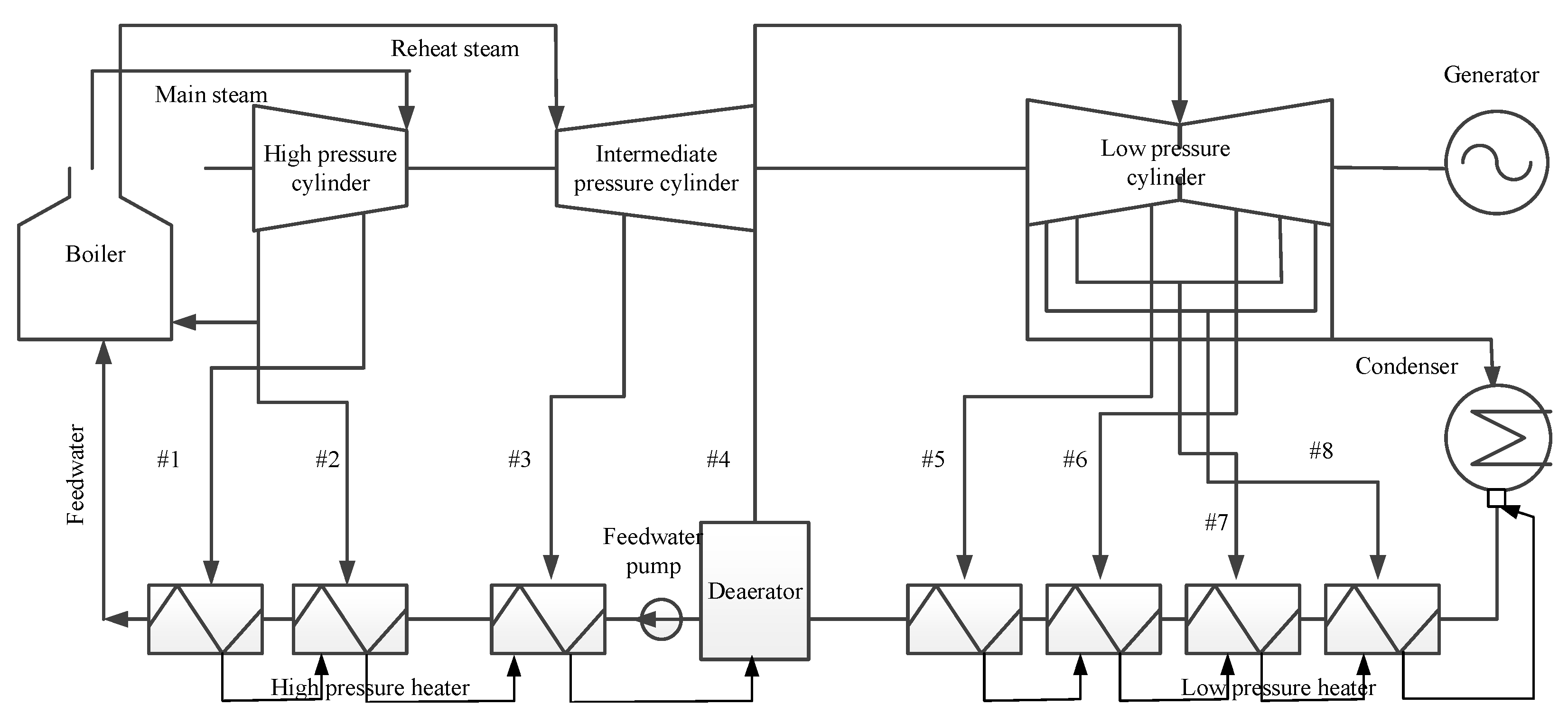
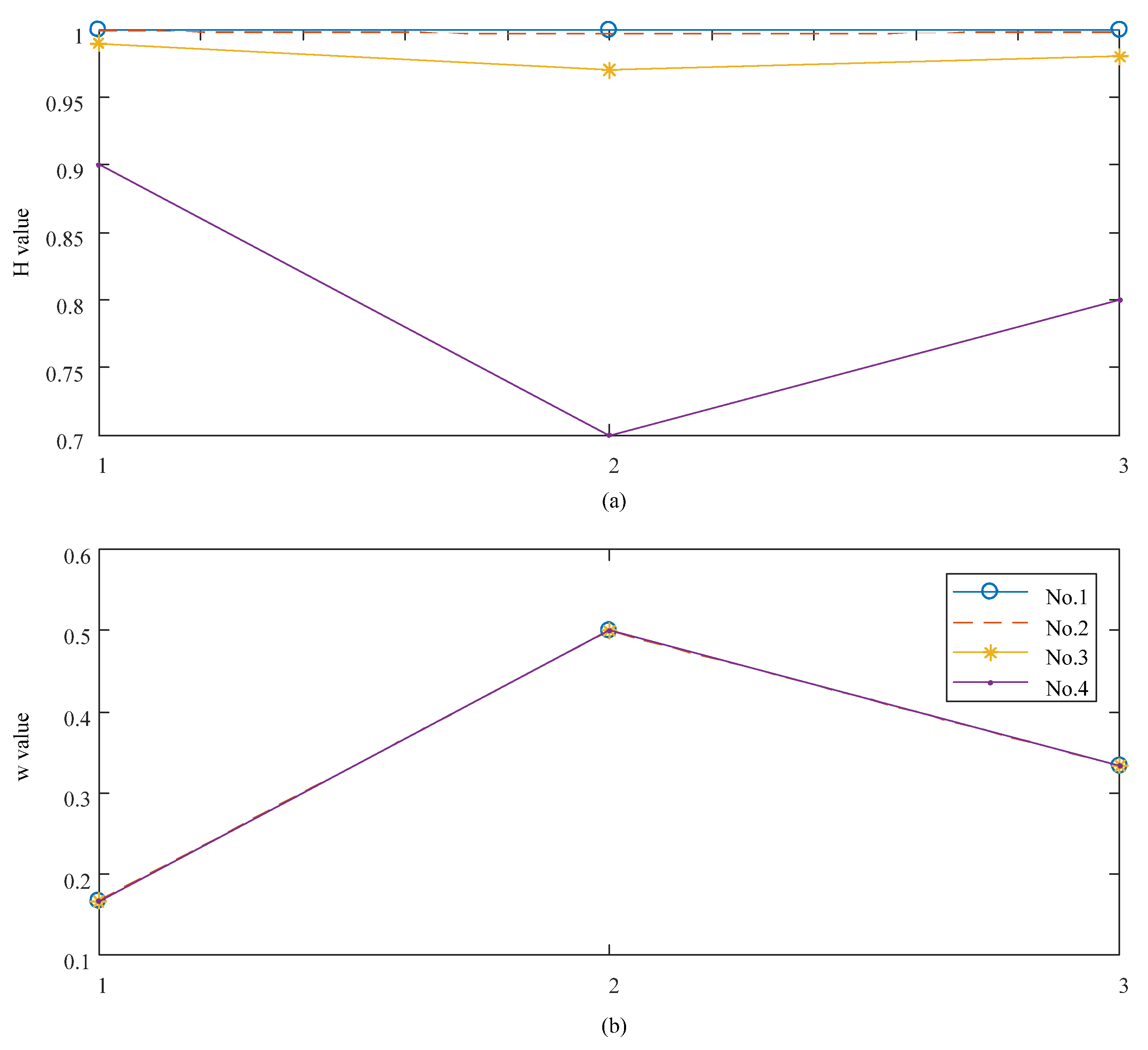

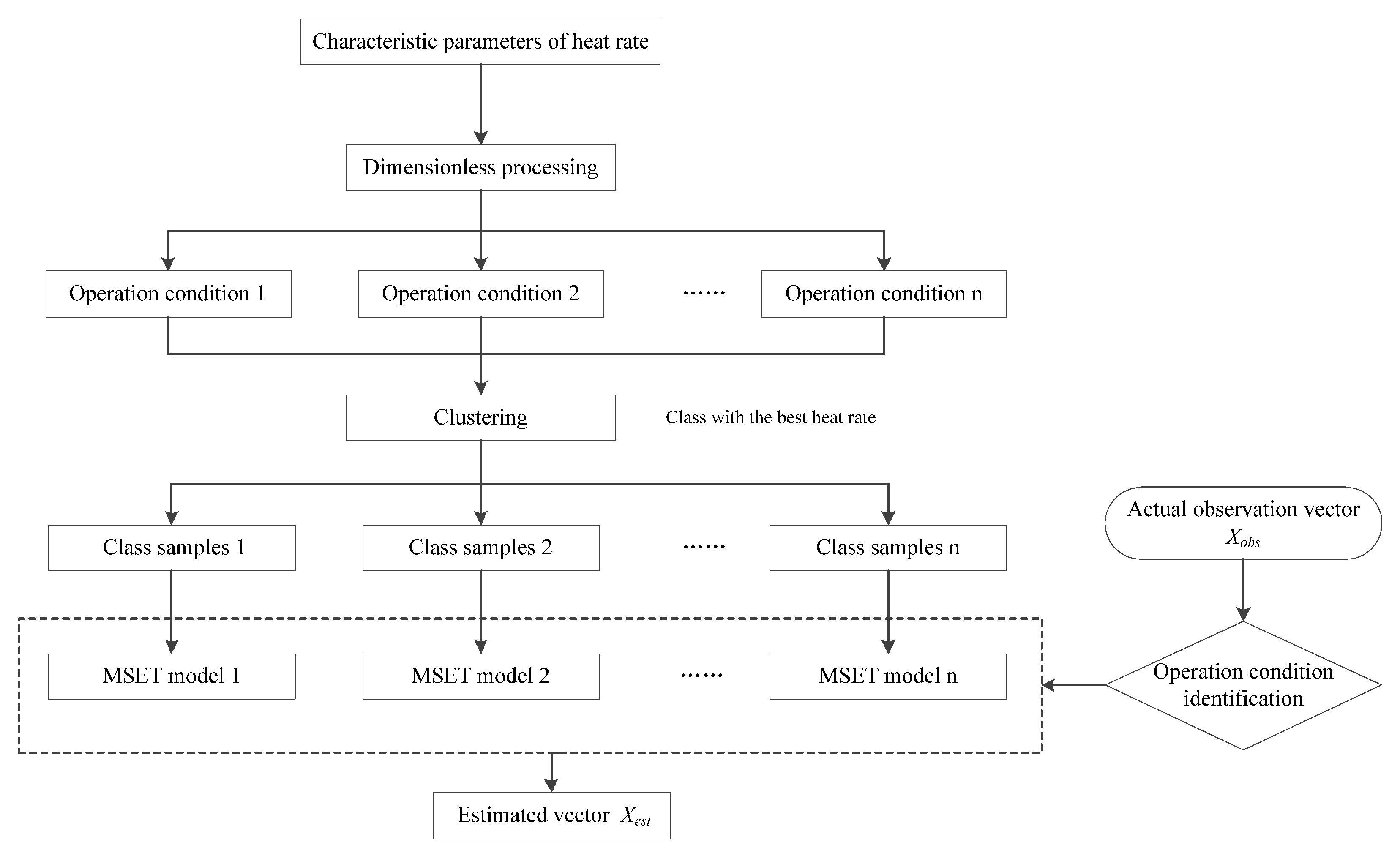
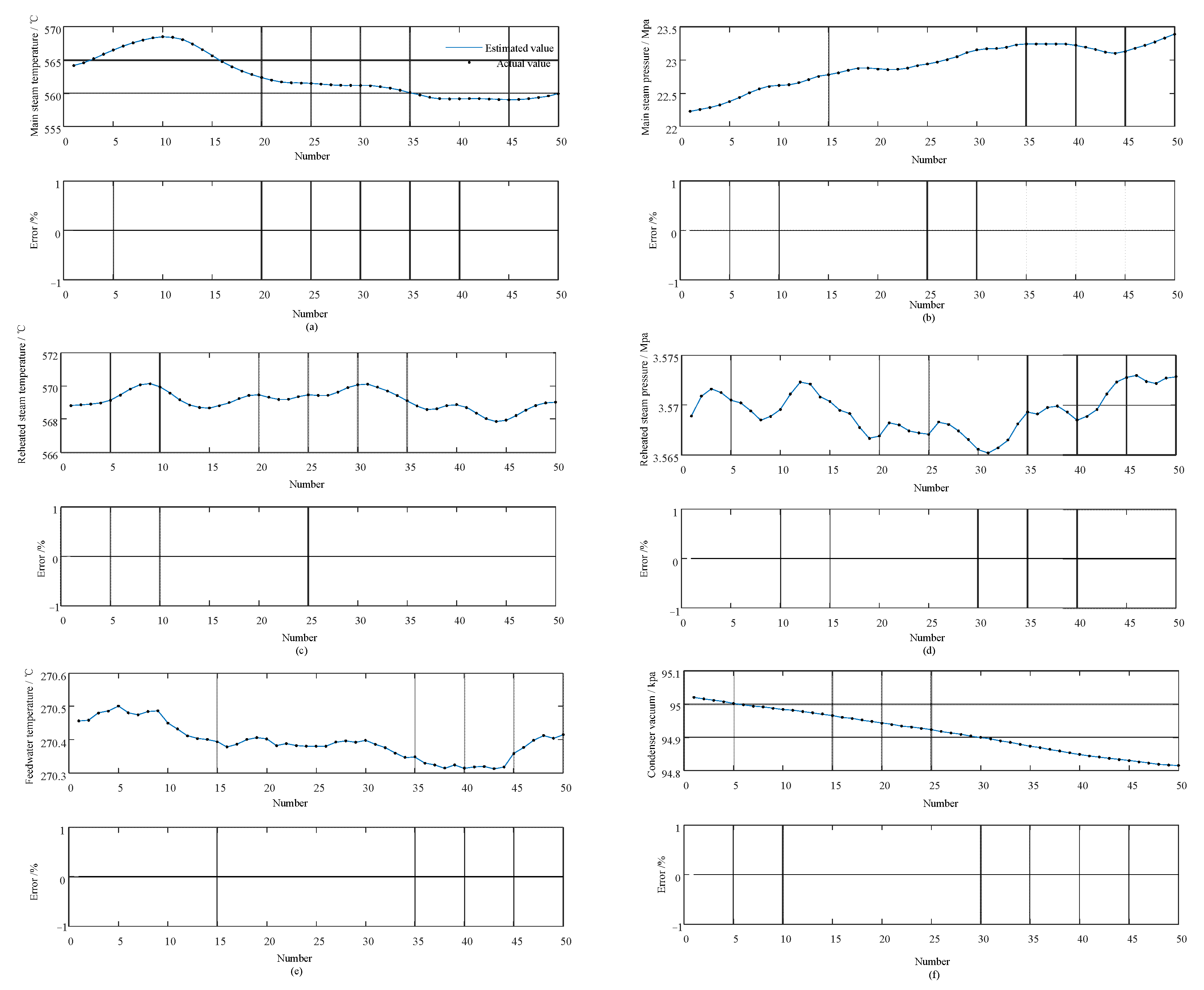
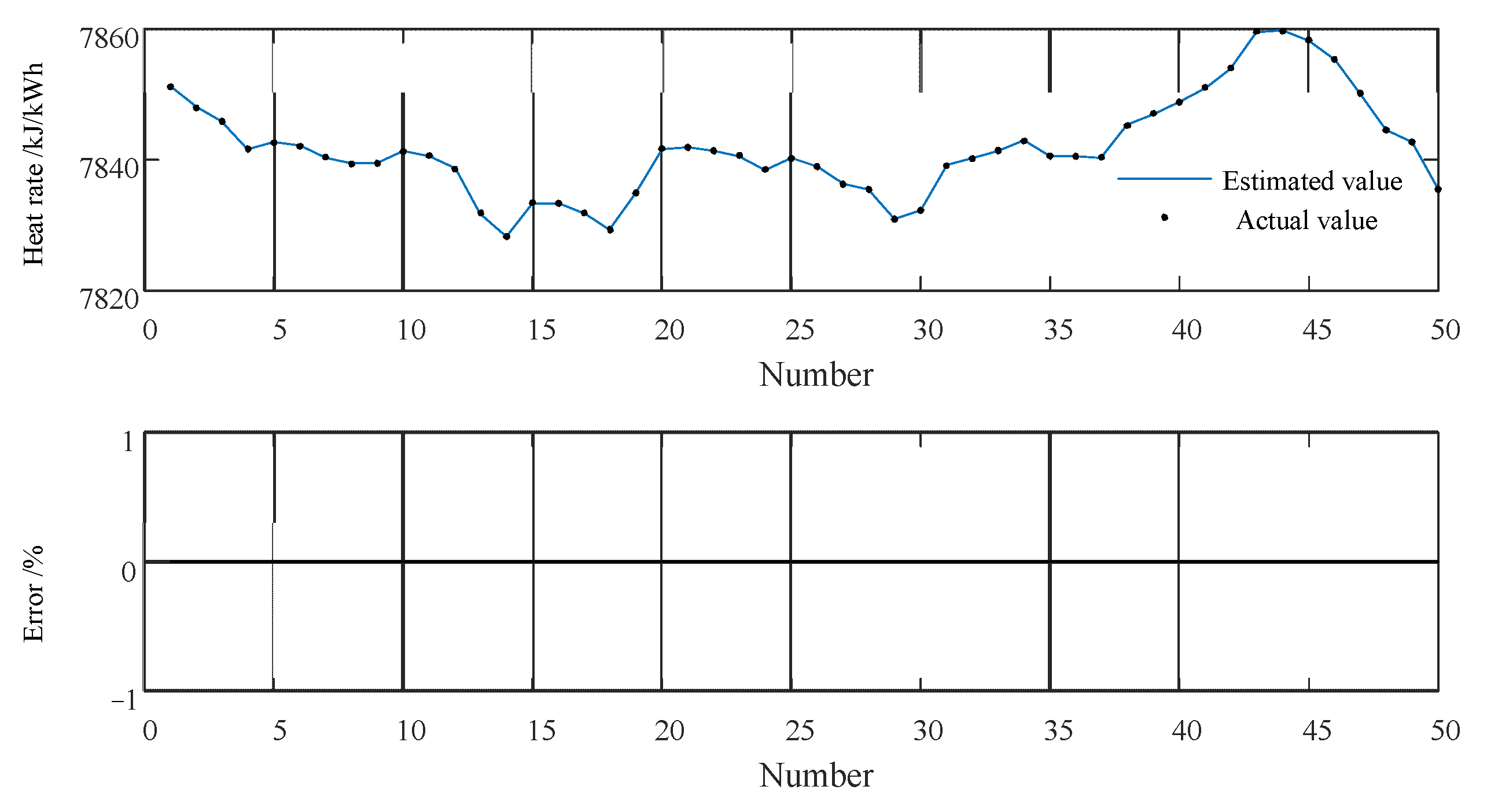
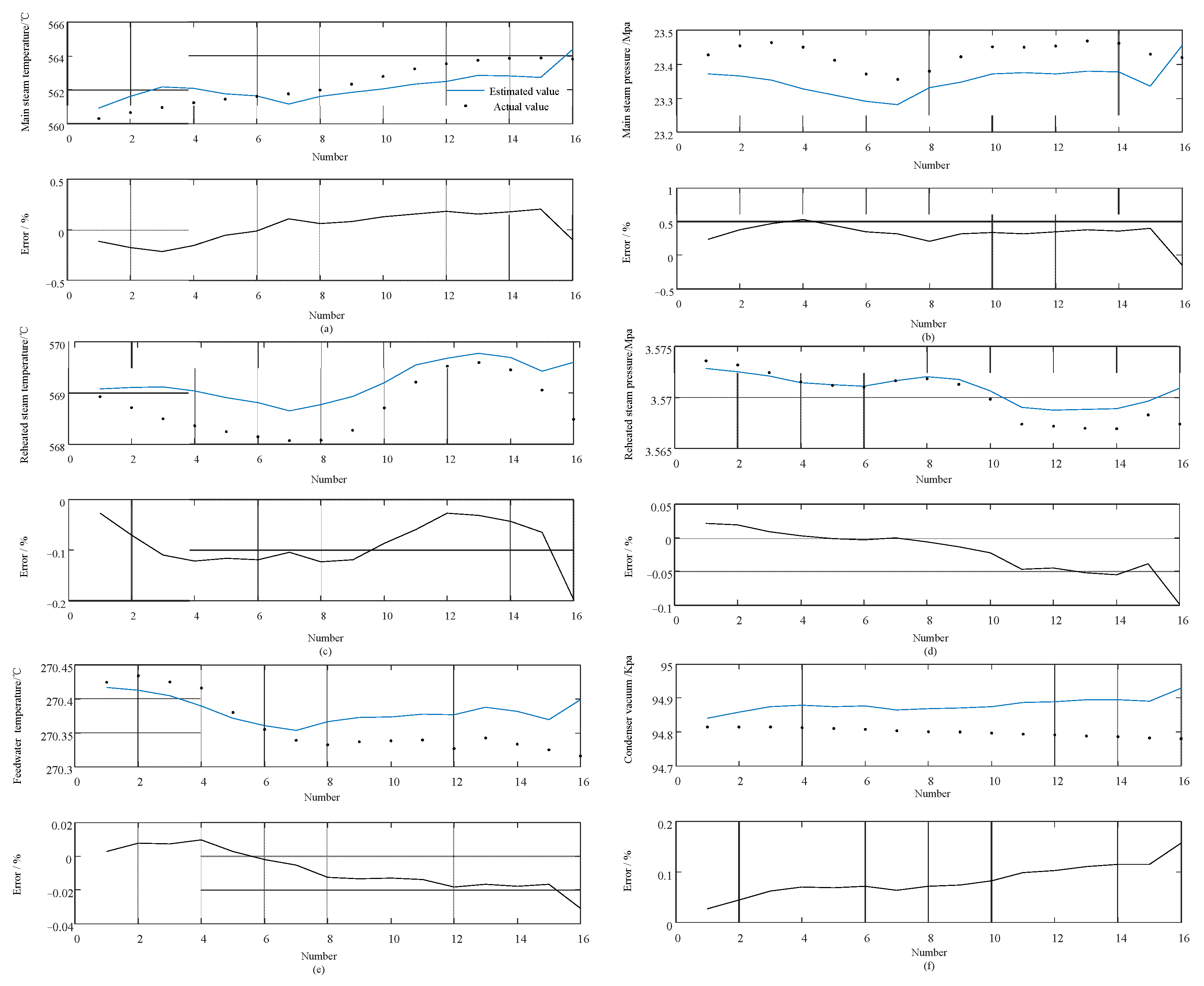

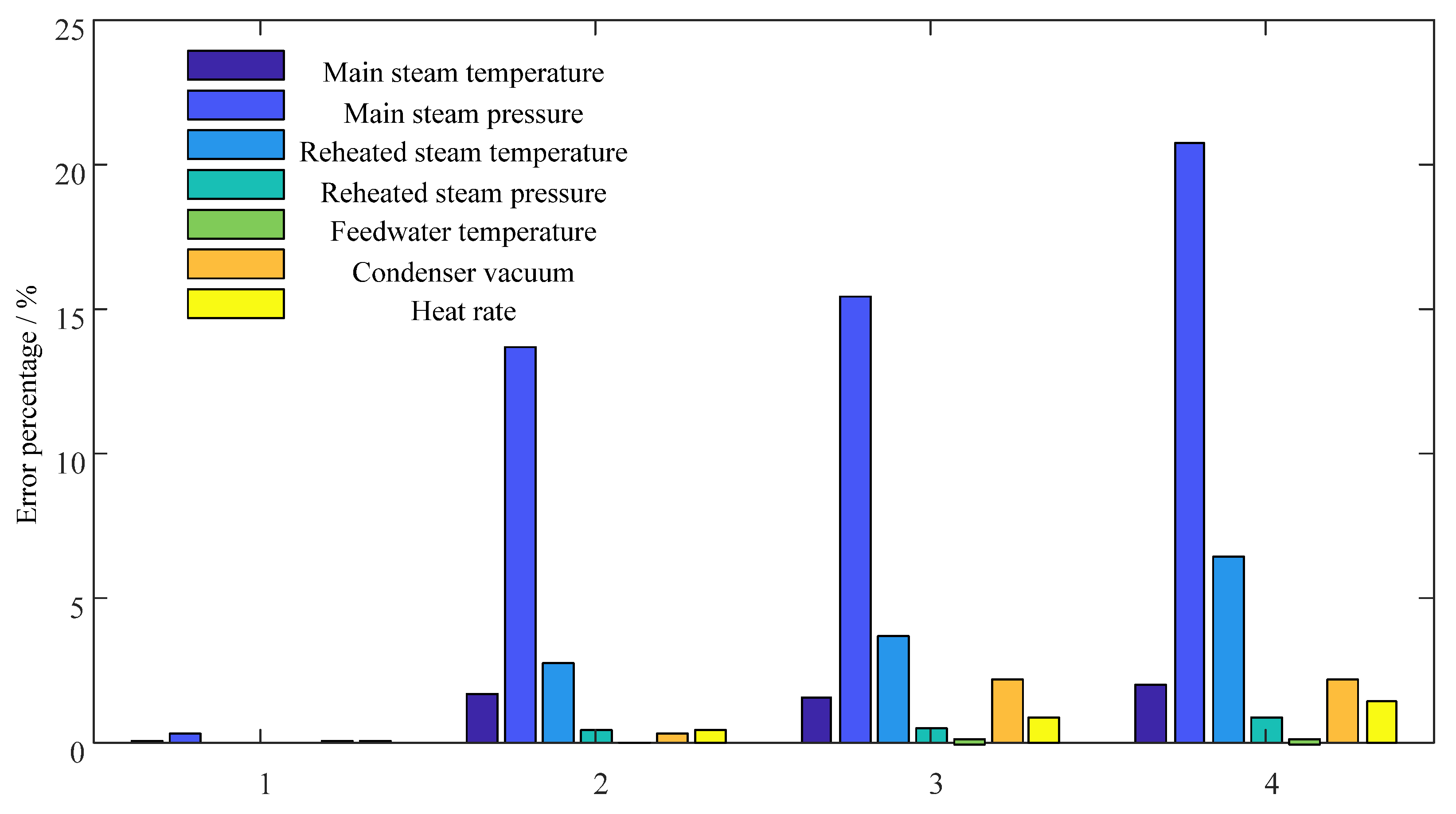
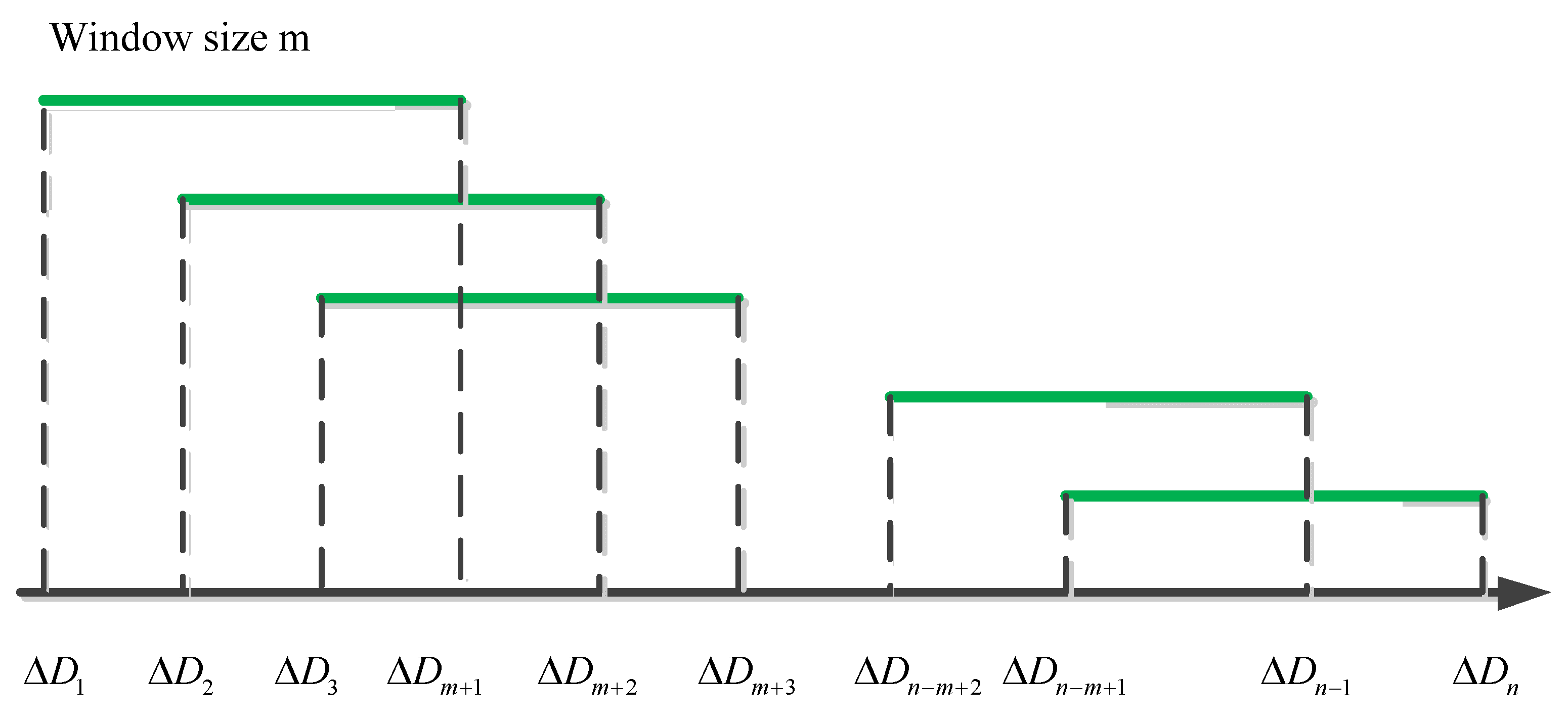

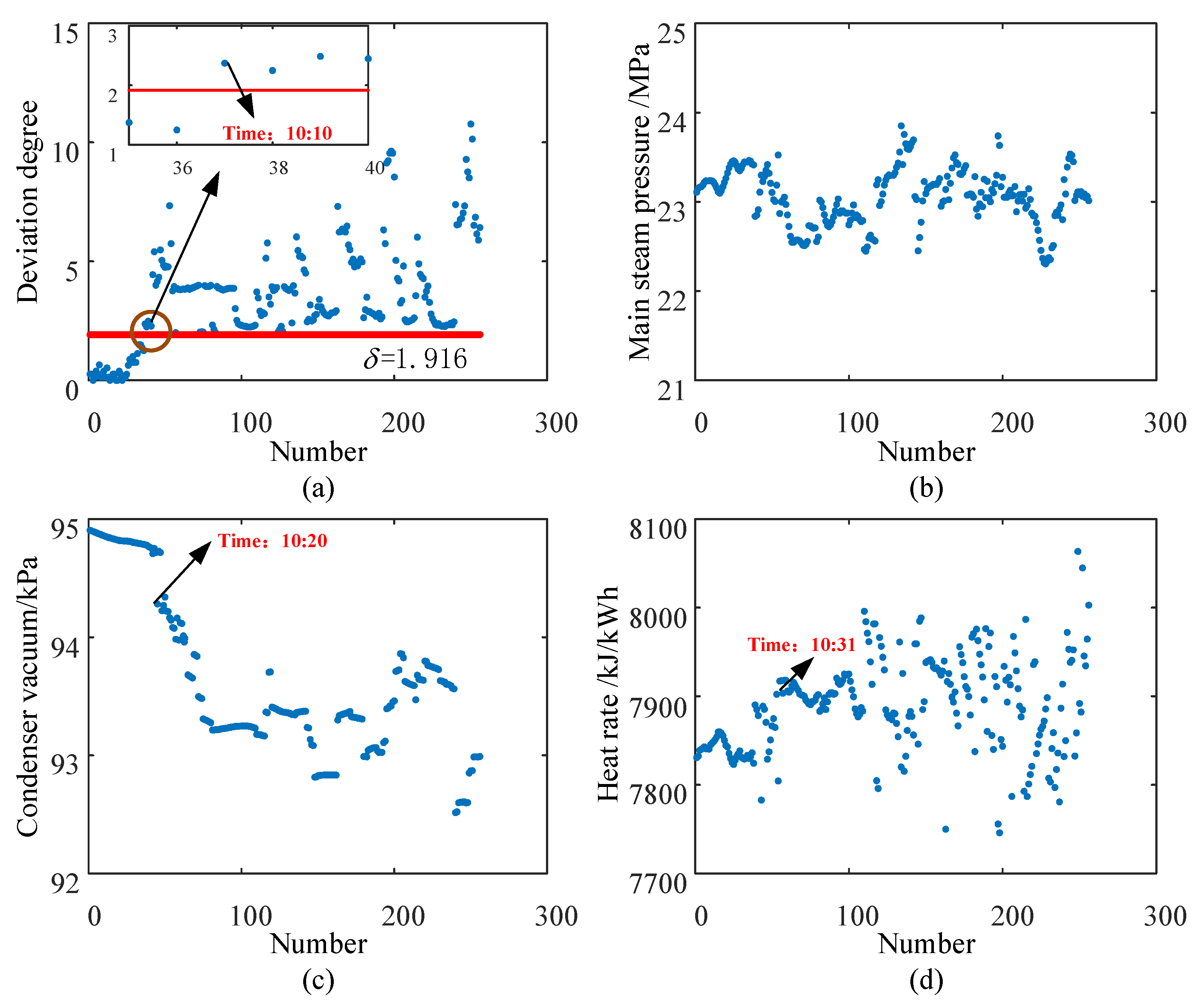
| Number | Entropy Value | ||
|---|---|---|---|
| H1 | H2 | H3 | |
| 1 | 0.9999 | 0.9997 | 0.9998 |
| 2 | 0.999 | 0.997 | 0.998 |
| 3 | 0.99 | 0.97 | 0.98 |
| 4 | 0.9 | 0.7 | 0.8 |
| n | 35 | 36 | 37 | 38 | 39 | 40 | 41 | 42 |
|---|---|---|---|---|---|---|---|---|
| 2.9987 | 2.9990 | 2.9991 | 2.9993 | 2.9995 | 2.9997 | 2.9997 | 2.9997 | |
| 3 | ||||||||
| 0.6666 | 0.6667 | 0.6667 | 0.6667 | 0.6667 | 0.6667 | 0.6667 | 0.6667 | |
| 0.6667 | ||||||||
| No. | Parameters | Unit | Attribute |
|---|---|---|---|
| 1 | Load | MW | Condition |
| 2 | Main steam temperature | °C | Condition |
| 3 | Reheated steam temperature | °C | Condition |
| 4 | Feedwater temperature | °C | Condition |
| 5 | Main steam pressure | Mpa | Condition |
| 6 | Reheated steam pressure | Mpa | Condition |
| 7 | Condenser vacuum | Kpa | Condition |
| 8 | Main steam flow | t/h | Condition |
| 9 | Feedwater steam flow | t/h | Condition |
| 10 | Condensate flow | t/h | Condition |
| 11 | Spray water flow | t/h | Condition |
| 12 | Regulating stage pressure | Mpa | Condition |
| 13 | Heat rate | kJ/kWh | Decision |
| Cluster Number | Data Numbers | Clustering Center of Heat Rate |
|---|---|---|
| #1 | 66 | 7839.0 kJ/kWh |
| #2 | 134 | 7857.3 kJ/kWh |
| #3 | 97 | 7899.4 kJ/kWh |
| #4 | 28 | 7933.1 kJ/kWh |
| No. | Parameters | Unit | Time 2020/05/17 | ||||||
|---|---|---|---|---|---|---|---|---|---|
| 9:34 | 9:35 | … | 13:03 | … | 13:48 | 13:49 | |||
| 1 | Load | MW | 550.70 | 550.49 | … | 551.46 | … | 548.53 | 550.71 |
| 2 | Main steam temperature | °C | 569.90 | 570.08 | … | 567.41 | … | 564.18 | 563.47 |
| 3 | Reheated steam temperature | °C | 561.20 | 561.18 | … | 563.29 | … | 558.92 | 558.34 |
| 4 | Feedwater temperature | °C | 270.39 | 270.40 | … | 270.87 | … | 271.35 | 271.21 |
| 5 | Main steam pressure | Mpa | 23.11 | 23.15 | … | 23.51 | … | 24.12 | 23.97 |
| 6 | Reheated steam pressure | Mpa | 3.57 | 3.57 | … | 3.62 | … | 3.62 | 3.64 |
| 7 | Condenser vacuum | Kpa | 94.90 | 94.90 | … | 93.60 | … | 92.99 | 92.99 |
| 8 | Heat rate | kJ/kWh | 7830.90 | 7832.25 | … | 7908.61 | … | 7964.54 | 8002.89 |
Publisher’s Note: MDPI stays neutral with regard to jurisdictional claims in published maps and institutional affiliations. |
© 2021 by the authors. Licensee MDPI, Basel, Switzerland. This article is an open access article distributed under the terms and conditions of the Creative Commons Attribution (CC BY) license (https://creativecommons.org/licenses/by/4.0/).
Share and Cite
Gu, H.; Zhu, H.; Cui, X. Multivariate State Estimation Technique Combined with Modified Information Entropy Weight Method for Steam Turbine Energy Efficiency Monitoring Study. Energies 2021, 14, 6795. https://doi.org/10.3390/en14206795
Gu H, Zhu H, Cui X. Multivariate State Estimation Technique Combined with Modified Information Entropy Weight Method for Steam Turbine Energy Efficiency Monitoring Study. Energies. 2021; 14(20):6795. https://doi.org/10.3390/en14206795
Chicago/Turabian StyleGu, Hui, Hongxia Zhu, and Xiaobo Cui. 2021. "Multivariate State Estimation Technique Combined with Modified Information Entropy Weight Method for Steam Turbine Energy Efficiency Monitoring Study" Energies 14, no. 20: 6795. https://doi.org/10.3390/en14206795
APA StyleGu, H., Zhu, H., & Cui, X. (2021). Multivariate State Estimation Technique Combined with Modified Information Entropy Weight Method for Steam Turbine Energy Efficiency Monitoring Study. Energies, 14(20), 6795. https://doi.org/10.3390/en14206795






